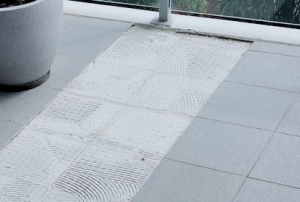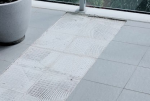What a pain. Several tiles on our balcony tented last week and we have managed to remove them without breaking any.
Other Units have had similar issues in the past, some a lot worse.
Here is the area shown with the tiles removed...

Analysis by Tiler
We had a tiler come look at the issue.
He can relay the tiles easily, but reports that there will be on-going issues with the rest of the balcony area.
The probable cause in his opinion is that the wrong adhesive was used beneath the tiles, the plastic spacers were left in each tile corner, and the grout was not a flexible grout that should have been used.
The tiler also checked the whole balcony area and states that about 50% of the tiles are "drummy" and could tent or break with expansion and contraction.
The tiles are an Owner responsibility so we are investigating replacing the entire balcony tiling.
About a year ago we had an extra expansion joint added in one area of the balcony. This was done to minimise the risk of tiles tenting.
One problem in doing that is that the air conditioner will need de-gassing, and be disconnected.
You too may be affected in the same way, as the initial construction was not done to Australian Standards.


















